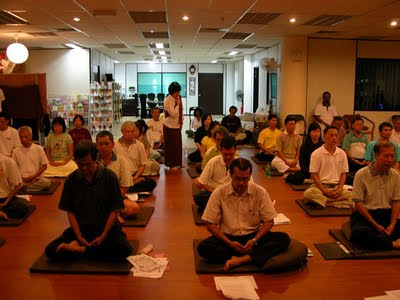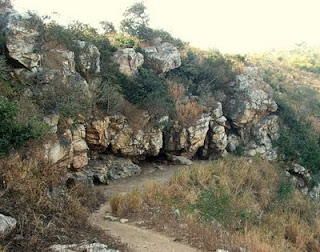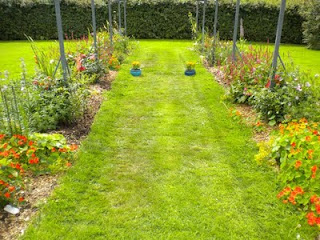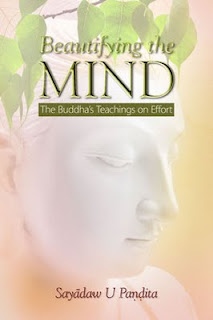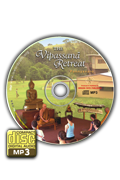
Dear Friends,
We are pleased to inform that our meditation teacher Visu and his wife Barbara are back from Europe after a five-month teaching stint — leading metta and vipassana retreats at various European centres.
Visu will resume his meditation classes at House of Inward Journey (52 Rangoon Road, Level D, Penang) every Tuesday and Thursday beginning on Jan 19 2010 until further notice.
The program is as follows:
T U E S D A Y
8:00pm to 9:00pm — Metta (Lovingkindness) Meditation
9:00pm to 10:00pm — Dhamma Talk and Discussion
T H U R D A Y
8:00pm to 9:00pm — Vipassana (Insight) Meditation
9:00pm to 10:00pm — Dhamma Talk and Discussion
For those of you who have been attending Visu's classes from February to June this year you are most welcome to resume practice with Visu.
For those who have not have the benefit to practice with Visu you are most welcome to now take the opportunity to do so.
If you have friends who are interested in learning meditation please invite them to come along. Visu will give simple and precise instructions to newcomers and beginners.
For the talk on Tuesday Jan 19 Visu will elaborate on the benefits of metta practice — why it is so helpful in our everyday life. This talk is aimed at motivating you to maintain a strong metta practice.
We will appreciate if you can send us an SMS or email or give us a phone call to confirm your attendance.
I can be reached at my mobile phone 012 4302893.
Email: inwardpath@hotmail.com
If you have any enquiries please contact me.
With metta (lovingkindness),
Sunanda Lim
* * *M E T T A (Lovingkindness)
May all beings be happy.
May they be safe.
May they be peaceful.
May they be healthy.
May they take care of themselves happily.
Metta is a Pali word meaning lovingkindness, goodwill, friendliness, benevolence, non-hatred, non-anger, non-irritation and non-annoyance.
Metta Meditation is the cultivation of lovingkindness, friendliness, benevolence, and goodwill through the continuous generating of wholesome thoughts and well wishes towards oneself, loved ones, friends, people we know and all beings in general.
Metta practice helps to free our hearts from hatred, anger and ill-will. It has a very positive effect on both oneself and others and is conducive to improving our relationships. We come to be more patient, tolerant, loving, friendly, kind and understanding in our relationships with others.
Metta meditation provides a wonderful complement to Vipassana (Insight) meditation as it helps us to develop concentration that can aid and support our Vipassana practice.
* * *
V I P A S S A N A (Insight)
Vipassana or Insight meditation is the direct and clear seeing into the true nature of mental and physical phenomena. It involves the application of mindfulness to closely observe our mind and body processes during formal sitting and walking meditation and in all other activities.
With practice we gain calm and peace as well as insight into our mental conditioning, behavioural patterns and habits. We learn how to cultivate, sustain and strengthen wholesome and joyful states of mind while diminishing the unwholesome and painful.
We will develop a skillful approach that is conducive to peace, joy and happiness in all aspects of our daily life.
Our practice is based on the Buddha's Discourse on the Four Establishments of Mindfulness. These are Body, Feelings, Consciousness or Mind States, and Dhammas/Phenomena. We will learn how to observe and investigate all these in our direct and immediate experience.
In due course we will come to understand what the Buddha called "The Three Marks of Existence" — Impermanence, Suffering/Unsatisfactoriness, and Not-Self.
The deep and profound understanding of these fundamental truths will lead to the liberation of the mind from all clinging and delusion that lie at the root of all suffering. Peace, release and happiness are the fruits of the practice.
Vipassana promotes true happiness, fulfillment and freedom in life while leading the practitioner to the ultimate and highest peace and happiness of Nibbana, the end of all craving/greed/attachment, hatred/anger/aversion and ignorance/delusion.
* * *
THE TEACHER
Visu (shortened from his full Pali name Visuddhacara) has been practising the Dhamma and meditation since 1982. He was born in Penang, Malaysia, in 1953. He was a journalist for 12 years and a Buddhist monk for 17 years before he returned to the lay life in 2003. He has studied with several meditation masters, notably Sayadaw U Pandita, Sayadaw U Lakkhana, Sayadaw U Jatila and Ven Sujiva. He is married and has led retreats in Asia, Australia and Europe. He is the author of several books including “Curbing Anger Spreading Love,” “Drinking Tea Living Life: Applying Mindfulness in Everyday Life and Critical Times”, “Loving and Dying” and “Hello with Love and other Meditations.”
Visu’s emphasis in his teaching is on the integration of the Dhamma in everyday life while striving for the ultimate release of Nibbana. He stresses the importance of cultivating lovingkindness, joy and happiness in the present moment while on our journey towards Enlightenment.
Retreat in Czech Republic Oct 2009
Visu and Barbara in Holland Sept 2009
 Giving Dhamma Talk at Kuching Dhamma Vijaya Centre,
Giving Dhamma Talk at Kuching Dhamma Vijaya Centre,
Kuching, Dec 2009










